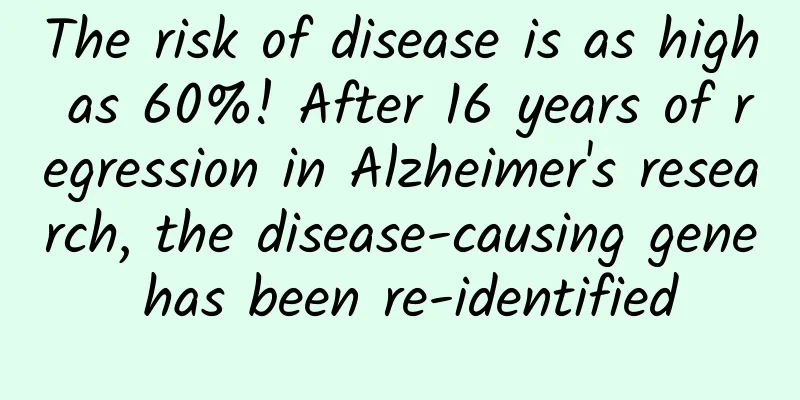The risk of disease is as high as 60%! After 16 years of regression in Alzheimer's research, the disease-causing gene has been re-identified

|
A hundred years have passed since Alzheimer's disease (AD) was first discovered, but people have not yet found an effective drug that can completely cure AD. The reason is that the pathogenesis of AD is very complex and difficult to analyze. One of the most classic hypotheses of AD pathogenesis is the Aβ amyloid protein pathogenic hypothesis. However, over the years, people have designed drugs targeting Aβ based on this hypothesis, but with little effect. In recent years, the most famous drug should be aducanumab launched by Biogen, but 40% of patients who injected the drug experienced terrible side effects such as brain swelling. In July 2022, the world's most authoritative academic journal Science published a six-month investigation report, which stated that American neuroscientist Sylvain Lesné had falsified academic papers, including a paper published in Nature in 2006 that established the Aβ amyloid protein pathogenic hypothesis. This report revealed the truth that has misled the academic community for more than a decade, but it also made the prospect of developing drugs to treat AD more confusing. More and more scientists and pharmaceutical companies are turning their attention to areas other than Aβ, such as gene regulation, energy metabolism, liposomes or glial cells. Through genomic studies, people have found that mutations in the three genes APP, PSEN1 and PSEN2 can cause early-onset autosomal dominant Alzheimer's disease (ADAD). The triploidy of the APP gene in patients with Down syndrome can lead to Down syndrome-associated Alzheimer's disease (DSAD). In addition, dozens of other genes (such as ICA1L, LIME1, SIGLEC11, GRN and TMEM106B) are associated with an increased risk of sporadic (late-onset) AD [1,2]. Among these numerous gene mutations, the APOE4 gene is considered to be the risk gene most associated with the onset of AD. People who carry two APOE4 alleles (APOE4 homozygous) have a 60% chance of developing AD around the age of 85, which is much higher than those who carry only one APOE4 allele (APOE4 heterozygous) or do not carry the gene. However, no studies have yet used APOE4 to predict the age of onset, nor have studies separated APOE4 homozygous and heterozygous to study their relationship with AD-related biomarkers. Recently, the research team of Víctor Montal from Hospital Sant Pau in Barcelona, Spain, published a research paper in the journal Nature Medicine titled APOE4 homozygozity represents a distinct genetic form of Alzheimer's disease. The research team proposed that APOE4 should be regarded as a pathogenic gene for AD, not just a risk gene. APOE4 homozygosity fully meets the three characteristics of genetically determined AD (usually familial inheritance): nearly complete disease penetrance (i.e., AD is almost certain to occur), predictable age of symptom onset, and predictability of changes in pathological features/biomarkers/clinical manifestations. Changing the definition of APOE4 will not only help to detect such AD patients in advance and intervene early, but will also provide a new direction for clinical drug development. The research team combined >3,200 pathological samples of AD patients provided by the National Alzheimer's Disease Coordinating Center (NACC) of the United States with data from >10,000 volunteers provided by five published large-scale multicenter AD biomarker research cohorts to study APOE4-related clinical, pathological characteristics, and biomarker changes. From the perspective of disease penetrance, almost all APOE4 homozygotes showed higher AD neuropathology scores, while only 50% of APOE3 homozygotes had scores above medium and high. Starting at the age of 55, the levels of biomarkers in APOE4 homozygotes have been significantly higher than those in APOE3 homozygotes. By the age of 65, almost all APOE4 homozygotes showed abnormalities of Aβ1-42 in cerebrospinal fluid, and 75% had scan symptoms of amyloid deposition. By the age of 80, the penetrance of biomarkers was as high as 88% (Figure 1). Figure 1 Changes in pathological characteristics of APOE4 homozygotes In terms of disease progression, APOE4 homozygotes develop AD symptoms at around 65.6 years old, mild cognitive impairment at 71.8 years old, complete dementia at 73.6 years old, and eventually die at 77.2 years old. These time points are 7-10 years earlier than APOE3 homozygotes. This shows that APOE4 increases the risk of AD and accelerates the disease progression of AD (Figure 2). Figure 2 Changes in pathological progression in APOE4 homozygotes From the perspective of biomarker changes, the age of onset for APOE4 homozygotes is 65.6 years old. As early as 10-15 years before that, the biomarkers in the cerebrospinal fluid and plasma of APOE4 homozygotes, such as p-Tau and NfL, had increased significantly compared with APOE3 homozygotes. In addition, PET scanning and analysis of confirmed AD patients found that almost all patients carrying the APOE4 allele had amyloid deposits, while only 50% of APOE3 homozygotes were PET amyloid positive. In terms of time, the changes in biomarkers of APOE4 homozygotes are also similar to those of ADAD and DSAD patients (Figure 3). Figure 3 Changes of biomarkers in APOE4 homozygotes with age It is also worth mentioning that the various phenotypic phenomena of heterozygous people carrying one APOE4 allele and one APOE3 allele are between those of APOE3 homozygous people and APOE4 homozygous people, which shows that APOE4 is dose-dependent, and the more APOE4 alleles a person carries, the more severe the symptoms will be. In general, through the above data results, the research team believes that APOE4 homozygotes fully meet the three major characteristics of AD defined by genes, and that we can no longer simply regard APOE4 as a risk gene for AD. Instead, we should change our mindset and define APOE4 homozygotes as the pathogenic gene of AD, just as we define carriers of APP, PSEN1 and PSEN2 gene mutations as suffering from ADAD, and define a completely new type of AD. At the same time, Professor Huang Yadong and others from the Gladstone Institute of Neurological Diseases in the United States published a review article in the journal Nature Medicine titled APOE4 homozygosity is a new genetic form of Alzheimer's disease [3], which highly praised the research content of this article (Figure 4). The review pointed out that APOE4 homozygotes account for about 2% of the global population, so APOE4 homozygosity may be one of the most prevalent Mendelian genetic diseases in the world. Defining APOE4 homozygosity as a pathogenic gene can not only improve people's understanding of AD, but also promote key changes in the diagnosis, management and care strategies of AD. Figure 4 APOE4 homozygotes meet the three major characteristics of AD defined by genes Defining APOE4 homozygosity as the pathogenic gene of AD can also prompt researchers to understand the specific mechanism behind APOE4 homozygosity leading to AD, and also open up new directions for drug development. This study has laid a solid theoretical foundation for CRISPR-based gene therapy. In fact, many studies have reported that APOE4 deficiency has an alleviating effect on the pathological characteristics of AD. For example, the Michael D. Greicius research team [4] used human data to confirm that APOE4 deficiency is not only normal, but also long-lived, and does not cause hypercholesterolemia, which shows that APOE4 deficiency is tolerable to the human body. The team led by Anastasia Khvorova and Chantal M. Ferguson [5] found that using small interfering RNA (siRNA) to silence the expression of the APOE4 gene can significantly improve the pathological characteristics of the AD mouse model. As for the underlying mechanism, Tony Wyss-Coray's team at Stanford University School of Medicine recently published a study in the journal Nature titled APOE4/4 is linked to damaging lipid droplets in Alzheimer's disease microglia. The study found that APOE4 exacerbates the accumulation of lipid droplets in microglia, thereby causing neuronal toxicity and leading to cell death[6]. In addition, defining APOE4 homozygosity as the causative gene for AD can also have a significant impact on clinical trial design. So far, APOE4 homozygosity has never appeared as a separate group in clinical trial design, and the emergence of this study reminds people that APOE4 must be recognized as a key parameter for trial design, patient recruitment, and data analysis, and APOE4 homozygotes and heterozygotes must be clearly separated. This approach can improve treatment efficacy and more effectively tailor therapeutic interventions to genetically defined patient groups. References: [1] Fortea J, Pegueroles J, Alcolea D, et al. APOE4 homozygozity represents a distinct genetic form of Alzheimer's disease. Nat Med. Published online May 6, 2024. doi:10.1038/s41591-024-02931-w [2] Bellenguez C, Küçükali F, Jansen IE, et al. New insights into the genetic etiology of Alzheimer's disease and related dementias. Nat Genet. 2022;54(4):412-436. doi:10.1038/s41588-022-01024-z [3] Xu Q, Liang Z, Huang Y. APOE4 homozygosity is a new genetic form of Alzheimer's disease. Nat Med. Published online May 6, 2024. doi:10.1038/s41591-024-02923-w [4] Chemparathy A, Le Guen Y, Chen S, et al. APOE loss-of-function variants: Compatible with longevity and associated with resistance to Alzheimer's disease pathology. Neuron. 2024. doi:10.1016/j.neuron.2024.01.008 [5] Ferguson CM, Hildebrand S, Godinho BMDC, et al. Silencing Apoe with divalent-siRNAs improves amyloid burden and activates immune response pathways in Alzheimer's disease. Alzheimers Dement. Published online February 20, 2024. doi:10.1002/alz.13703 [6] Haney MS, Pálovics R, Munson CN, et al. APOE4/4 is linked to damaging lipid droplets in Alzheimer's diseasemicroglia. Nature. 2024;628(8006):154-161. doi:10.1038/s41586-024-07185-7 |
<<: Cold and flu, what's the difference?
>>: What you think is a “wealth bag” may not be a sign of wealth! Can it be removed?
Recommend
Uterine fibroids B-ultrasound picture
When a woman has any discomfort, she will go for ...
There are tips for breast enhancement: eight foods that promote estrogen
Among all the breast enhancement secrets of celeb...
What are the symptoms and dangers of cervical cysts?
The incidence of many gynecological diseases is i...
What if my period comes half a month early?
Everyone says that the most troublesome animal on...
Hand numbness during sleep
If women experience numbness in their hands durin...
Can pregnant women eat watermelon seeds?
The physical health of the mother is what the fam...
Acute upper respiratory tract infection, how to take care of it
Acute upper respiratory tract infection refers to...
Is it OK to eat motherwort after abortion?
After an abortion, women should pay special atten...
Can I drink maple syrup during my period?
Menstruation is a physiological cycle unique to w...
After sitting on a plane for several hours, I stood up and suddenly died! What happened?
There was a case where a passenger suddenly died ...
What is the cause of vaginal body odor?
We all know that body odor usually appears in the...
It is the most weight-loss fruit in autumn, I don’t allow you to not know it!
We often say that it is unreliable to "lose ...
Why do dentists prefer metronidazole when treating swollen and painful gums? What should you pay attention to when using it?
A friend of Huazi had swollen and painful gums. H...
How many times does it take for menstruation to become regular after childbirth?
There are many different names for menstruation n...
How to regulate Yin deficiency and dampness and heat constitution? An old Chinese doctor teaches you how to regulate
In traditional Chinese medicine theory, there are...









